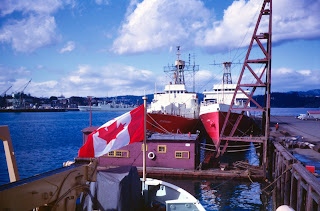



While working in Canadian shipping I had an opportunity in 1967 to make an interesting voyage to a unique part of the World. This was Canada's Confederation Year and The Marine Board of Canada was changing to the Canadian Coastguard. Since the Canadian Coastguard Academy did not exist at that time officers with Foreign-going Certificates of Competency were being recruited. So it was that I received an appointment as 2nd. Officer (Deck) in the Canadian Coastguard Pacific Region based in Victoria, BC out on Vancouver Island. At that time Canada manned Ocean Station "Papa" a floating weather station in the North Pacific. Two vessels alternated on Station both former Her Majesty's Royal Canadian Navy World War 2 class vessels. CCGS "Stonetown" and CCGS "St. Catherine's" they were, to say the least, rather battered and sea weary. The North Pacific is somewhat misnamed and both ships had cracks just aft of midships, not really a very comforting fact. So it was that two replacement ships were built CCGS "Vancouver" and CCGS "Quadra". I was assigned to the CCGS "Vancouver" based at the Royal Canadian Navy Base Esquimalt,BC. It was an interesting experience as sea trials were still being completed and there was lots going on. It was my first ship with a flight deck, a bow thruster and flume-tank stabilization system for starters. Lots to learn and set-up systems for all hands. In conversations in the Wardroom I learned about Arctic ice breaking and the result was I applied for a transfer to icebreakers. Within a month I found myself as a Watchofficer in CCGS "Camsell" a buoy-tender/icebreaker. After some Patrols around Vancouver Island servicing some thirty light stations and lots of small boat work we prepared for the Arctic. On Wednesday July 05, 1967 on WAP 67 we headed North from CCG Base Victoria,BC. This was The Canadian Confederation Year's Western Arctic Patrol 1967. Our voyage took us up the Inside Passage then out into the North Pacific through the Aleutian Islands. Then up the coast of Alaska via the Bering and Chukchi Seas to the northern Alaskan and Canadian Arctic coasts. We returned to Victoria, BC on Tuesday October 03, 1967 after 91 days at sea. During our Patrol we flew our helicopter, escorted supply ships servicing the DEWline stations, gave health care to Inuit villages, transferred RCMP dog teams, built radar reflector towers, laid out disposable navigation buoys (made out of oil drums) and placed weather buoys. So we were kept busy enough, not overly so, but definitely no boredom set in.
Good Watch
Comments